#volt catfish
Photo








Rockman X3 (ロックマンX3) - 1996
#blast hornet#blizzard buffalo#gravity beetle#toxic seahorse#volt catfish#crush crawfish#tunnel rhino#neon tiger#explose horneck#frozen buffalio#gravity beetbood#acid seaforce#electro namazuros#scissors shrimper#screw masaider#shining tigerd#mega man x#mmx#mega man x3#mmx3#x3#rockman x#rockman x3#psx#playstation#ps1#sega saturn#90s#anime#aesthetic
97 notes
·
View notes
Text
Blast Hornet: Spike Rosered kissed me!
Volt Catfish: Oh my X! Oh my X! Oh my X!
Blast Hornet: It was unbelievable!
Volt Catfish: Oh my X! Oh my X! Oh my X!
Gravity Beetle: Okay, we wanna hear everything. Volt Catfish, get the wine and unplug the phone. Blast Hornet, does this end well or do we need tissues?
Blast Hornet: Oh, it ended very well.
Volt Catfish: Do not start without me! Do not start without me!
Gravity Beetle: Okay, alright, let’s hear about the kiss. Was it a soft brush against your lips or was it like a, you know, “I gotta have you now” kind of thing?
Blast Hornet: Well, at first it was really intense, you know? And then, oh X, and then we just sort of sunk into it.
Gravity Beetle: Ohh…So, okay, were they holding you? Or were their hands on your back?
Blast Hornet: First he started out on my waist and then he slid up and then he were in my motherboard.
Volt Catfish and Gravity Beetle: Ohhh.
*meanwhile*
Spike Rosered drinking tea in their house: And, uh, and then I kissed him.
Toxic Seahorse: Tongue?
Spike Rosered: Yeah.
Tunnel Rhino: Cool.
#Megaman#Megaman X#Blast Hornet#Volt Catfish#Gravity Beetle#Toxic Seahorse#Tunnel Rhino#Spike Rosered#incorrect quotes#Source: ???
4 notes
·
View notes
Text
Ureaaggggghhhhhh
* fart reverb *
LeBron James
19$ fortnite card who wants it
* bOoOOIIIiiIiIIING *
DEEZ NUTS!!!!
oof!!!!!!
* taco bell chime *



#megaman#mega man#megaman x#megaman x6#megaman x4#megaman x3#metal shark player#volt catfish#jet stringray#oh my god im so fucking scared#what have they done to my sons#fart reverb
4 notes
·
View notes
Note
well i already know a handful of your lore but ..you watched a bunch of fan sprite animations growing upand your styles really expressive because of it
I GUES !!!! i did watch a lot of sprite animations i think if they influenced my style it was subconsciously but still....
2 notes
·
View notes
Photo

This may come as a shock… but the electric eel (Electrophorus electricus) isn’t an eel. It's technically a knifefish and is more closely related to catfish and carp! This hefty critter, which can reach lengths of 8 ft (2.4 m) and weigh as much as 45 lbs (20.4 kg), delivers a charge of more than 650 volts—that’s more than five times the power of a standard outlet in the United States. Its slimy skin acts like a shield, protecting it from its own shocks. This fish inhabits the Amazon and Orinoco Rivers in South America. With poor eyesight, it relies on electrolocation to find prey, releasing small electrical discharges as it hunts. The electric eel also uses its unique abilities to stun prey and keep predators at bay. Photo: Oleksandr (Alex) Zakletsky, CC BY 4.0, Wikimedia Commons #nature #science #wildlife #amazingnature https://www.instagram.com/p/CpxxwSZL11h/?igshid=NGJjMDIxMWI=
777 notes
·
View notes
Text
Wet Beast Wednesday: electric eel
Prepare to be jolted this Wet Beast Wednesday as we dive into the shocking world of electric eels. The fist thing to know about electric eels is that the name is a lie. Not the electric part, that's true, but the eel part. Despite appearances, electric eels are actually knifefish, a group of freshwater fish that are more closely related to catfish and piranha than to true eels.

(Image: three electric eels swimming in an aquarium. One in front is seen in profile. It is an elongates, slender, brown fish with tiny pectoral fins and a long anal fin that runs under most of the body. End ID)
There are three species of electric eel, though they are so similar to each other that they were previously classified as one species. The species are Electrophorus electricus, Electrophorus voltai, and Electrophorus varii. The main difference between the species are in the shape of the skull. All electric eels are elongated fish that are cylindrical at the front and flattened vertically at the tail. They have no pelvic or dorsal fins and the tail fin is small and fused with the anal fin, which runs across most of the body. The anal fin is the primary means of locomotion for the eels. By undulating the fin in a wavelike motion, the eel can swim forward, backward, or hover in place. The body of the eel is scaleless, instead bing covered in muddy brown skin. Electric eels grow throughout their entire lives and grow new vertebrae as they get longer. The largest species, E. electricus, can reach 2 meters (6.6 ft) long and weighs up to 20 kg (44 lbs). They are obligate air-breathers, being incapable of obtaining enough oxygen through their gills to survive. Instead, they must surface every two to ten minutes to breathe. The inside of the mouth is wrinkly and heavily vascularized, resulting in a high surface area that can absorb oxygen as long is it stay wet. The floor of the mouth can flex to draw air in and then it is forced out through the gills. Carbon dioxide is excreted through the skin. Electric eels have poor eyesight, but have electroreception and very good hearing thanks to Webers apparatus, a set of tiny bones that connect the inner ear to the swim bladder. The apparatus amplifies sounds that the ear would not be able to detect on its own.

(Image: a close-up of an electric eel's head. It is round and brown, reminiscent of a potato in texture. The mouth is located on the frond and is closes, with no visible teeth. Tje eye is very small and pale blue. Across the head are sensory pits that look like small holes. End ID)
All of the vital organs of the eels are packed into the first fifth of its body length. The rest of the body contains the electric organs. Keeping the vital organs in the front of the body isolates them from the electric organs, preventing the fish from damaging their organs while generating electricity. The electric organs take up so much more space because they need to generate very powerful electric shocks. Most fish that hunt with electricity are saltwater species as salt water conducts electricity much better than freshwater. Because electric eels are freshwater fish, they need to generate much more powerful shocks to effectively hunt other animals. E. voltai can produce a maximum recorded 860 volts of electricity, the highest of any animal. Electric eels are electroreceptive, able to sense electric fields in their surroundings. Electroreception is divided into passive (animal senses electric fields of others) and active (animal generates its own electric field and can sense distortion in that field caused by other objects or animals). Electric eels are active electroreceptors. They sense changes in their electric field using sensory pits on the head that are derived from the lateral line system that all fish have. Electric eels have three electric organs: the main organ, Sach's organ, and Hunter's organ. The main organ sits in from of the Sach's organs while the Hunter's organ sits beneath both. The organs are derived from muscles and consist of stacks of structures call electrocytes, which are made up of specialized cells. When the brain sends a signal to the electric organs to produce a shock, special ion channels pump sodium ions into the cells while different channels pump potassium out. This creates a sudden difference in electric potential, which is what generates the shock. Producing electricity is a costly process and the eels need rest and nourishment between multiple successive shocks. The main organ generates the powerful shocks used to stun prey while the Sach's organ creates weaker shocks used for active electroreception. Hunter's organ appears to support the other two.
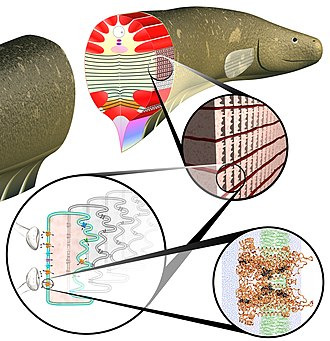
(Image: an artistic depiction of a cross-section of an electric eels, showing the structure of the main electric organ. From there, the image is zoomed in on multiple times, showing the the structure of the electrophytes, the protein channels, and the structure of the proteins involved in generating electricity. End ID. Art by Daniel Zukowski)
Electric eels are found in northern South America and the ranges of the three species generally do not overlap. They prefer muddy bottoms or swampy areas. The terrain of their territory changes quite a bit through the year. In the wet season, water levels rise, flooding sections of forest and grassland and connecting streams and ponds. In the dry season, water levels drop and many streams and ponds are isolated. These isolated bodies of water become warm, low-oxygen areas where fish that rely on gills are at a disadvantage while air-breathing fish like the electric eels can thrive. Electric eels are nocturnal predators that detect and stun prey through their electric abilities. Their diet consists mostly of fish, but they will take just abut anything. While mostly solitary, E. varaii have been observed coordinating with each other to hunt schools of tetras. When the electric field generated by Sach's organ is disturbed by another animal, the eel will use the main organ to produce a strong shock to stun the prey. Stunning can be done from a distance, but is more effective if the eel makes contact with the other animal. An initial shock may be used to temporarily immobilize prey long enough for the eel to contact it and release a second shock. Some sources propose that the eel can use its shock to forcibly contract muscles in other animals, either immobilizing prey or forcing prey to move, making them easier to sense. Where or not this is something the eels can actually do is up for debate. Electric eels also use their shocks to deter potential predators. When feeling threatened by something on land, the eel can leap out of the water to make contact with the threat and shock it. Very few animals prey on electric eels, but known predators include caiman, alligators, and piranha.

(Image: six frames showing na electric eel in captivity responding to a perceived threat (a fake caiman head) by partially leaping out of the water and contacting the head to shock it, before returning to the water. End ID)
Electric eels breed in the dry season. Males will use their saliva to glue together mud and sand into nests where the females lay their eggs. The male then fertilizes the eggs by releasing sperm onto them. The females may lay eggs multiple times during the breeding season and can lay up to 1200 at a time. The male stays by the nest to guard the eggs and hatchlings for up to four months. The lifespan of electric eels is in question, but captive specimens can live for up to 20 years.

(Image: an electric eel resting on a pile of wood next to some rocks. End ID)
All species of electric eel are classified as least concern by the IUCN, meaning they are not at threat of extinction. Threats to them mostly consist of pollution and habitat loss. Studies of the electric properties of the eels have lead to multiple discoveries and inventions. In particular, Luigi Galvani was inspired by studies on the eels when he invented the battery. Electric eels are also important in the study of the voltage-gated sodium channel. These channels are used to generate electricity, but are also used to trigger the contraction of muscle cells in many species, including humans. It is hard to study the channels in muscle cells because they are found in very small amounts. The electric organs of the electric eel have much higher quantities of these channels, making it much easier to study them. Better understanding of voltage-gated sodium channels could lead to improvements in prostheses and medical implants.
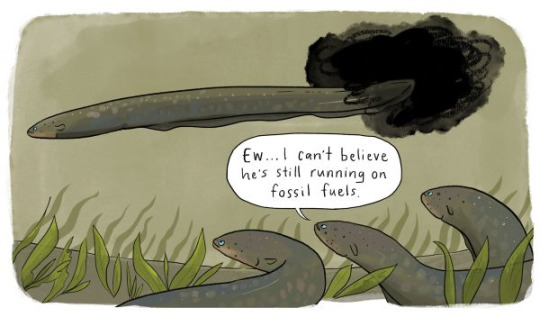
(Image: a cartoon showing an electric eel swimming with a black cloud emerging from its tail. Threee other eels watch from the side, one commenting "Ew... I can't believe he's still running on fossil fuels". End ID. Source)
#wet beast wednesday#electric eel#fish#fishblr#knifefish#freshwater fish#biology#zoology#ecology#animal facts#informative#science
101 notes
·
View notes
Text
Daily fish fact #577
Electric catfish!

This family of catfish has well-developed electrogenic organs, as in organs that generate electric fields! They can generate as much as 350 volts of electricity, and they were occasionally used by ancient Egyptians to reduce arthritis pain!
152 notes
·
View notes
Text
I was looking at electric eel facts for eel vessel and I found some cool stuff-
- males can make nests of saliva
- they grow about 2 to 13 feet
- they prefer calmer waters
- they can survive in both salty and fresh water
- they have horrible vision at birth, so they use the other senses
- they breath air and have to go up every 10 minutes
- they don’t have lungs so they “gulp” the air instead
- they’re carnivores, but will eat fruit if it’s dropped into the water
- they’re not really eels, but knifefish
- they’re mostly related to catfish
- they wrap themselves around their pray then electrocute it
- they don’t have scales
- they can’t live in the deep sea
- they don’t reproduce at a high speed
- they don’t swim fast in the water
- their head resembles the positive end of a battery
- the tail length consumes most of the eel’s height
- they feed off of crustaceans, invertebrates, amphibians, birds, and smaller fish
- they’re not aggressive in the wild, only until they sense harm
- they have very strong teeth for ripping apart pray and scaring off predators
- they can produce up to 600 volts (or more depending on how big it is)
- not much is known about their reproduction but they do mate for life
- females are larger than males
So yea electric eels are cool-
23 notes
·
View notes
Text
Che sennò non mi da pace, questo essere vivente ✨ @ilmostrochecamminatragliuomini
Last Song: November Rain
Last Show: Catfish🤡
Currently Watching: Rewatch di HIMYM, ancora.
Currently Reading: Sangue e Cenere
Current Obsession: Cod e bestemmie volanti (a volte)
Per il tag BEH chiunque legga ✨✨✨
3 notes
·
View notes
Text
Warfly fixation mode activated
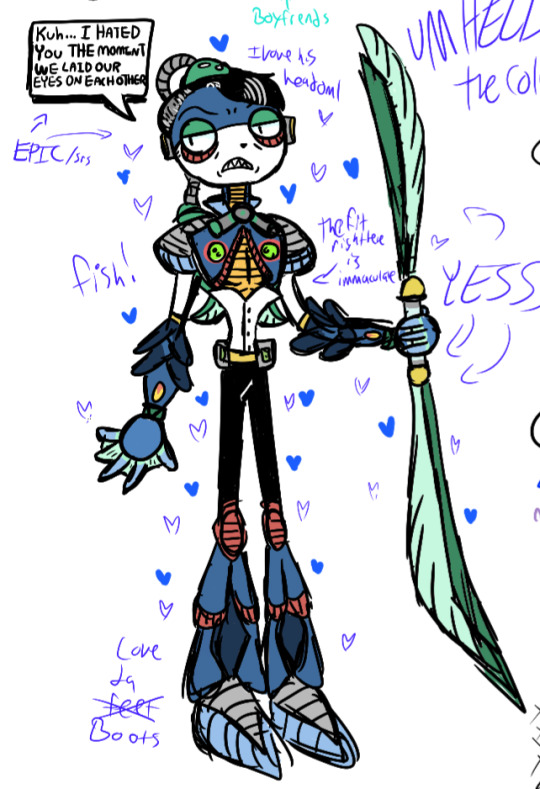





#megaman x#mega man x#megaman x7#megaman#splash warfly#volt catfish#humanized characters#scotch art#warfly brain rot warfly brain rot war fly brain rot warfl
4 notes
·
View notes
Text
Fish with electrogenesis usually produce electric charges through electrocytes or electroplaques—typically flat, disc-like modified muscle or nerve cells all stacked together. In marine fish, these cells are connected like batteries in a parallel circuit, whereas in freshwater fish they are connected like batteries in series. These latter fish are capable of producing discharges of higher voltage, because fresh water doesn’t conduct electricity as well as salt water. Each cell in the battery can produce nearly 0.15 volts by pumping out positive sodium and potassium ions. The electric eel has around 5,000 or 6,000 electroplaques in its abdomen, allowing it to generate shocks as strong as 600 volts to stun its prey. It also can lower its voltage pulses to around 10 volts to navigate and to detect prey. As a result of its electrogenerative abilities, the electric eel is found only in freshwater habitats, as salt water can have the unhelpful effect of causing the fish to naturally short-circuit. The electric ray, which has no such problem, has a pair of special kidney-shaped organs at the base of the pectoral fins that generate and store electricity and send out charges from 8 to 220 volts to electrocute prey or to stun a possible predator.
Electric catfish, common in African fresh waters, generate their electrical discharges from their skin rather than from electric organs that consist of individual electroplacques. When a foraging torpedo ray detects prey it swims forward and upward, exposing its ventral surface toward the fish while emitting low-frequency voltage pulses. The currents passing through the victim’s body excite its nerves and muscles, stunning it and immobilizing it, whereupon the torpedo descends over it and consumes it while continuing to emit pulses. Large Atlantic torpedo rays can generate enough power to produce a shock of up to 220 volts ; that’s enough voltage to run a household appliance, such as a blender or a clothes dryer.
Weakly electric fish, like the elephantnose fish, use their electrogenerative ability either to navigate, or locate prey, or to communicate. Instead of the electroplaques as in the electric eel, they have electric organs consisting of columns of electrocytes that generate relatively feeble electric fields. This type of active electrolocation relies on the ability of the elephantnose fish and other species that use it to detect any distortions in an electric field of less than 1 volt.
Although it’s not well understood how the brain extracts all of the sensory information for active electroreception, the sensors (also called electroreceptors) in the skin are sensitive to the rate of change of voltage across their cell membrane. In contrast, sharks and rays as well as most species of catfish use passive electroreception where the animal senses the weak bioelectric fields generated by other animals.
Sharks are the most electrically sensitive animals known; they respond to non-alternating current (DC) fields as low as 5 nanovolts per centimeter and can use this ability to detect a small fish buried in the sand.
Among groups of knifefish, the strongest adult male lets his presence be known by sending out the highest rate of electrical discharge—900 pulses per second. The rest of the males have lower frequency rates and are careful not to interfere with the frequencies of others. However, when a rival wants to challenge the dominant male, the challenger also will generate pulses at a frequency of 900 hertz to jam the signal. In response, the dominant male might zap his rival with a higher frequency charge of up to 1,000 hertz. But if the rival male continues to challenge and jam, the two males will probably fight it out physically, sometimes ending up locked jaw-to-jaw for an entire night.
0 notes
Note
the best part of voltes v legacy is beastfighter no. 5, daiga.
he has the dumbest face imaginable. he looks like a blue shrek doing the trollface. i hope he becomes a big meme
This is kinda late, but he does look funny lol. I'd personally pick Namazuka to be funnier just because of how Big Bert/Daijirou reacted to it haha. He's such a funny character. It's a a gag that Namazuka looked like a catfish, and when they defeated it, they said they could finally cook it to eat lmaoo.
1 note
·
View note
Text
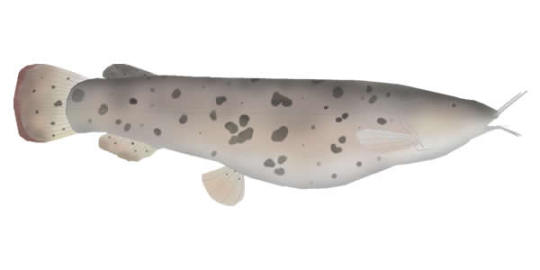
Electric Catfish - is a member of the Electric Catfishes family. It is native to tropical Africa and the Nile River basin. It is nocturnal and carnivorous and feeds primarily on other fish, incapacitating their prey with electric discharges (300 to 400 volts). It can reach a maximum length of 122 cm (about 48 inches) with a maximum published weight of 20.0 kg (about 48 pounds). All profits from sale will be given to the Lighthouse Mission to assist the homeless. https://www.redbubble.com/shop/ap/147107578
0 notes
Text
L’immagine infedele
Ho passato lungo tempo a guardare le tue foto che ho quasi creduto che fossero reali.. inizia così uno dei brani della band new wave “The cure”.
Questa non è una recensione sul gruppo musicale né tantomeno si vuole percorrere la storia della new wave, quanto piuttosto questa frase ha un senso nell’ambito fotografico e nel mondo del digitale ha un suo peso.
Si tratta del cosiddetto Catfish. Col termine Catfish nel mondo del web si intende quell’utente che assume una falsa identità per adescare un altro utente.
A volte lo si fa per motivi frodali altre come esamineremo per puro piacere di essere un’ identità immaginaria.
Un narciso evoluto, Narciso è colui che si innamora della sua stessa immagine, mentre qui l’immagine è completamente falsata. L’immagine reale di un’altra persona viene rubata, e a quell’immagine si crea una nuova identità con nome, personalità, gusti.
Nel mondo del web, il rapporto di scambio e di relazione tramite immagine è molto più diffuso e facilitato, attenzione per i nostalgici o per i complottisti del web, questa modo di comunicare/ relazione veniva già praticata ai tempi della cosiddetta corrispondenza epistolare.
Il punto di questa riflessione è di come ci affidiamo all’immagine, quanto crediamo fedelmente e ciecamente la fotografia.
È come se il fatto di essere nata da un processo puramente scientifico le conferisca pieno potere, piena rappresentazione assoluta del vero.
Eppure dietro alla macchina fotografia e ora allo schermo di un cellulare, c’è sempre qualcuno/a che sa assolutamente cosa vuole lasciare far vedere.
Esattamente e prepotentemente si può affermare che alla base di tutto c’è una volontà, un libero arbitrio, un lascia passare del proprio modo di vedere e/o di lasciarsi vedere.
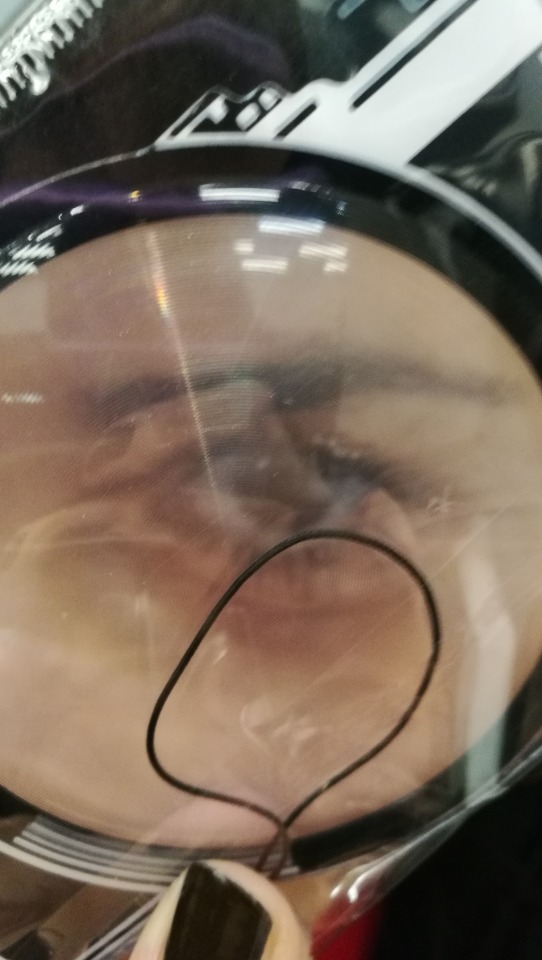
Siamo tutti vuoiyer , ci piace osservare le fotografie degli altri per dimostrarci che facciamo parte dello stesso mondo e a questo si aggiunge anche una forma di piacere.
La cosidetta bell’immagine ci invoglia ad osservarla e in alcuni casi anche a fantasticare.
Del resto la stessa playboy ha fondato il suo imparo sulle immagine delle cosidette conigliette avvenenti e provocatrici; solo con un’immagine è possibile cadere nella voglia dell’eros.
Nell’immagine trasferiamo tutti i nostri sentimenti anche quelli più nascosti, quelli che non oseremmo mai dire. È come se l’immagine accettasse per quello che siamo e lo fa in silenzio.
Ma a volte, come spesso accade, c’è un morso della mela che può essere fatale. Dietro all’immagine c’è una realtà completamente diversa.
Come nel caso del recente fatto di cronaca in cui un ragazzo conosce una ragazza online e si infatua, anzi perde la testa per questa ragazza giovane e carina. I due addirittura si dichiarano amore fidandosi solo delle immagine che i due si scambiano, eppure dietro all’innocente immagine della ragazza si celava un uomo di 64 anni…
Altro fatto sempre in epoca recente che ha fatto il giro del web, si tratta sempre di un Catfish questa volta l’immagine della ragazza non era stata rubata, come solitamente questa pratica prevede, piuttosto l’immagine viene costruita attraverso l’intelligenza artificiale, una serie di filtri abbastanza disponibili sui social trasformarono il volto di un uomo in una Kawai girl.
“ È la menzogna veramente una cosa terribile? Non credo, è solamente un metodo che ci permette di moltiplicare la nostra personalità ” Oscar Wilde, Il ritratto di Dorian Gray,1891

Trauma, 2021 ©Roberta Guarnera
1 note
·
View note
Audio
Mega Man X3
Volt Catfish
#megaman#megaman music#mm music#megaman x3#music of the day#oh this one so needed a better guitar#that riff is so simple yet it gets stuck into my head#it could have worked as a sigma fortress theme
1 note
·
View note
Link
Check out this listing I just added to my Poshmark closet: POOL BLASTER Water Tech Max and Catfish Ultra Reusable Sand & Silt Filter Bag.
0 notes